Blockchain Weekly Report | New Crown Inspiration: Creating a Blockchain Infectious Disease Early Warning System
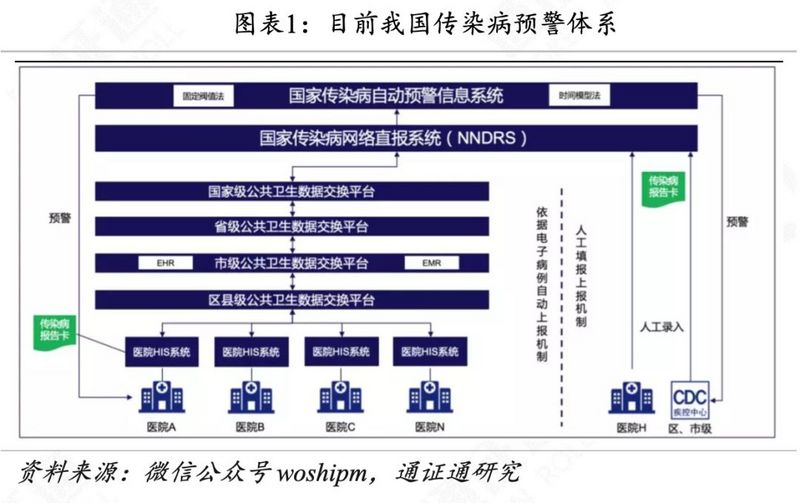
Guide
In early 2020, a new outbreak of coronary pneumonia occurred in Wuhan, the capital of Hubei Province. At 2 am on January 23, Wuhan closed all passages from Han, and the epidemic prevention and control fight officially started. The struggle between people and viruses is still continuing. At the same time, we should also reflect on the shortcomings of infectious disease surveillance and early warning, emergency response speed, and donated material management exposed by this epidemic, and consider using blockchain technology to optimize the above processes. Program.
Summary
- Mutual treasures use blockchain to process New Crown virus claims, can it subvert traditional insurance companies?
- Study | Charities in Epidemic Need Blockchain More
- Popular Science | Concise Ethereum 2.0 Introduction
Special topic: Enlightenment from the new crown to build a blockchain infectious disease early warning system. In 2008, China launched an automatic infectious disease early warning system nationwide, but there are still three shortcomings: insufficient efficiency to respond to emergencies, the formation of "information islands" between grassroots hospitals, and limited ability to deal with unknown diseases. The rational use of blockchain technology can solve the pain points of existing systems. The blockchain infrastructure can take advantage of data sharing, distributed, and weakly centralized collaborative governance to improve efficiency; establish an incentive / penalty system based on data authenticity rather than the number of confirmed patients, to drive data-driven decisions; when an epidemic breaks out, Blockchain's immutability and traceability can also play an advantage in public opinion release, data tracking, and epidemiological investigations. At present, there are more mature application cases of blockchain in related fields in the world, and blockchain has high application value in the traceability of epidemic prevention materials.
Quotes: Thick accumulation and thin hair, BTC once again hit 10,000 knives. The ChaiNext Digital Asset 100 Index closed at 917.43 points this week, up 8.7%. The ChaiNext Digital Asset 100X Index closed at 2578.04 points, up 16.5%. The total market value of digital tokens this week was US $ 284.42 billion, an increase of US $ 22.25 billion from last week, or an increase of about 8.5%; the average daily transaction volume was US $ 119.46 billion, an increase of 12.5% from last week. BTC's current price is $ 9795.9, a weekly increase of 4.8%, and the average daily trading volume is $ 31.2 billion. The current price of ETH is US $ 222.73, with a weekly increase of 23.6%, and the average daily trading volume is US $ 13.96 billion. The BTC balance of the exchange this week was 798,100, an increase of 50,800 compared with last week. There was a small accumulation of chips in the market, which may cause some pressure on short-term prices. In the BICS industry, the number of payment and settlement projects has grown rapidly.
Output and popularity: The growth of computing power has slowed down, or it may usher in an inflection point. The mining difficulty of BTC this week was 15.46T, which is not adjusted this week; the average daily computing power is 110.6EH / s, which is 1.0EH / s lower than last week. ETH mining difficulty this week was 2089.9, an increase of 32.1 over last week, and an average daily computing power of 166.2 TH / S, an increase of 1.9 TH / S over last week. ETH fever has risen slightly this week.
Industry: Blockchain helps fight new crown pneumonia. Wuhan University team launches a blockchain-based information exchange platform to combat new crown pneumonia protection materials; the Haidian District Market Supervision Bureau does a good job of epidemic prevention and control through blockchain and other methods; the IRS said that digital tokens will continue to be its Focus of work in 2020; Sun Yuchen has been invited to dinner with Buffett.
Risk warning: regulatory policy risks, market trend risks
text
1 Special topic: Enlightenment from the new crown-build a blockchain infectious disease early warning system
In early 2020, a new outbreak of coronary pneumonia occurred in Wuhan, the capital of Hubei Province. At 2 am on January 23, Wuhan City ’s New Coronavirus Pneumonia Epidemic Prevention and Control Headquarters issued Circular No. 1 to close all access roads from Han, and the epidemic prevention and control fight officially started. As of February 9, there were 37,000 confirmed cases of new crown pneumonia and 29,000 suspected cases. Medical teams and material resources from all over the country are constantly being sent to Hubei, and the struggle between the people and the virus continues. At the same time, we should also reflect on the deficiencies in the monitoring and early warning of infectious diseases, the response speed of emergency plans, the management of donated materials, etc. exposed by this epidemic, and the plan to optimize the above process using blockchain technology.
1.1 Existing infectious disease warning system is slightly bloated
In the face of public health emergencies, how to make the national and local disease control and emergency systems operate most quickly and efficiently is a key point in handling emergency situations.
In 2008, China launched an automatic infectious disease early warning system nationwide. This system can automatically analyze and warn the monitoring data of dozens of known infectious diseases. The specific process is: if an infectious case is found in the clinical work of the basic-level hospital, fill in the infectious disease report card, submit it to the hospital information management system, and then the same type of case data from multiple hospitals will be uploaded to the district, city, province, and national The exchange platform will eventually submit the case information to the national automatic warning system for infectious diseases for processing.
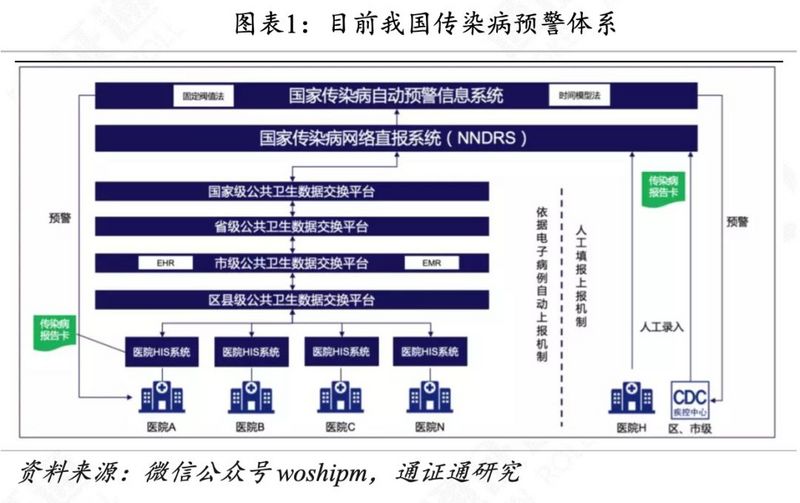
The early warning system has three main shortcomings: First, the efficiency is not enough to deal with emergencies. In the process of submitting infectious diseases to higher authorities, they will undergo manual intervention and review at three levels (department, district, county, and city-level disease control centers), which will be inefficient in the face of emergencies; Information islands. " The infectious disease information reporting network has a tree structure, and it is difficult to share case information between primary-level hospitals. Primary-level medical staff cannot make accurate judgments on the epidemic situation of the area and take countermeasures. The hierarchical reporting system has resulted in only the National Centers for Disease Control capable of coordinating the overall situation and making response decisions. 3. The system is more effective in dealing with known infectious diseases, but has limited ability to deal with unknown diseases. The above three factors make the system lack of ability to handle emergencies.
The early warning system of infectious diseases is a huge project involving many aspects of society, which also means that it is necessary to improve the efficiency of information transmission. Since October 2019, the country has raised the blockchain technology to a strategic height of core technology breakthroughs. After the epidemic, the adoption of blockchain technology to optimize infectious disease surveillance networks and automatic early warning systems should become a topic worth exploring.
1.2 Three Pain Points of Blockchain for Early Warning of Infectious Diseases
The general process of establishing an automatic early warning system for infectious diseases on the blockchain is to abandon the existing hierarchical information reporting system and establish an alliance chain consisting of grass-roots hospitals, district and county-level disease control centers, and provincial and city-level disease control centers. The open data principle of the block chain puts confirmed or suspected case data on the chain.
In the process of case chaining, big data analysis and other methods can also be adopted to drive data-driven decision-making. In the process of processing, the patient's private information is separated from the symptoms data, and the patient's symptoms and various physical indicators are extracted to provide early warning for large-scale similar short-term symptoms and suspected new infectious diseases. On the other hand, establish an incentive / penalty system based on the authenticity of the data rather than the number of confirmed patients. Each hospital can be responsible for verifying the case data on the chain, and each hospital can perform cross-validation to reward the nodes that upload real case data, and punish the upload of false, Concealed data nodes.
County and city-level disease control centers are the basic window for reporting infectious cases. Hospitals and county-level disease control centers have the obligation and responsibility to report cases of infectious diseases. They are the basis for the country's overall surveillance, early warning, and control of the epidemic. The use of the alliance chain can timely feedback case information, reduce unnecessary approval and manual intervention links, and if necessary, decentralize the authority to take some emergency measures to the grass-roots disease control center. Basic-level hospitals can also form sub-networks according to regions, share case data in the area, and take advantage of the distributed and weakly centralized collaborative governance of the blockchain.
When the epidemic breaks out, the blockchain's immutability and traceability can also play an advantage in public opinion release, data tracking, and epidemiological investigations. The automatic infectious disease early warning system can also be combined with the mobile phone operator's positioning system, the public security department's population information system and travel big data to quickly grasp the range of activities of patients with infectious diseases and the contact history of the source of suspected cases to improve the efficiency of isolation and diagnosis To reduce the phenomenon of patients concealing illness and contact history.
At present, there are several cases of mature blockchain applications in the fields of public health and emergency handling, which have some enlightening effects on the development of blockchain infectious disease early warning systems.
In 2018, the United States CDC and IBM cooperated to automatically collect health data through blockchain technology, track U.S. public health issues, slow down epidemic outbreaks, and antibiotic and opioid crisis. The United States CDC also expects blockchain technology to play a key role in more processes for disease prevention, including event detection, situational awareness, incident reporting, sample tracking, results reporting, outbreak management (intervention and response management, inventory allocation and distribution) )Wait.
ERIS epidemic surveillance system SERIS based on blockchain and IoT. Its design goal is to track the data uploaded to the blockchain platform by mobile phone operators such as call and location records, census data, transportation systems and Ebola vaccine production databases, and other real-time contact tracking, transmission mode monitoring and Vaccine distribution. After the system is modified, it can be applied to the surveillance of infectious diseases such as influenza, malaria, measles and polio.
1.3 Blockchain “guards” frontline supplies of the epidemic
A few days after the epidemic spread, Wuhan's frontline medical supplies for the epidemic were declared urgent. The supply of masks, protective clothing, and goggles to ensure the safety of medical personnel is in short supply. People from all walks of life across the country have voluntarily set up rescue teams to raise funds and donate materials to help Wuhan.
Although the donated materials are out of good intentions, they also face two major pain points: how to ensure the quality of medical supplies and monitor the whereabouts of donated materials. Recently, many medical workers in Wuhan Union Medical College reported that they did not receive the donated materials and donated masks of unqualified quality.
JD.com released the second edition of the JD.Blockchain Technology Practice White Paper in 2019 and officially open sourced the underlying framework system of the JD Chain blockchain. The blockchain system has been applied in the fields of product traceability and anti-counterfeiting, asset management, digital deposit and other fields. Taking vaccines as an example, blockchain technology can open up all links of vaccine production, cold chain logistics, CDC procurement and distribution, vaccination stations, vaccination records, case feedback, etc., and solve the traditional vaccine manufacturing process with many business links, opaque information, and difficult business Pain points such as right confirmation and difficult supervision effectively solve the problem of fake vaccines.
The blockchain has mature solutions to the problem of anti-counterfeiting of donated materials, but no progress has been made in the distribution of materials. Although all parties actively contacted the hospital to confirm the quantity, standards, and delivery of the required materials, the hospital still had problems of "difficulty in receiving" and lack of medical supplies. If the public welfare and the blockchain can be combined, each donation record and material distribution record can be chained, and the supply chain of important medical supplies can be traced, which may improve the opaque and difficult supervision of charities.
2 Quotes: Thick accumulation, thin hair, BTC impact on the knife barrier
2.1 The overall market: accumulation of thin hair, BTC once again hit the knife
The ChaiNext Digital Asset 100 Index closed at 917.43 points this week, up 8.7%. The ChaiNext Digital Asset 100X Index closed at 2578.04 points, up 16.5%. The 100X index without BTC rose by 16.5% this week, which was about 12 percentage points higher than the weekly increase of 4.8% by BTC. The main circulation certificate ushered in an explosive period.
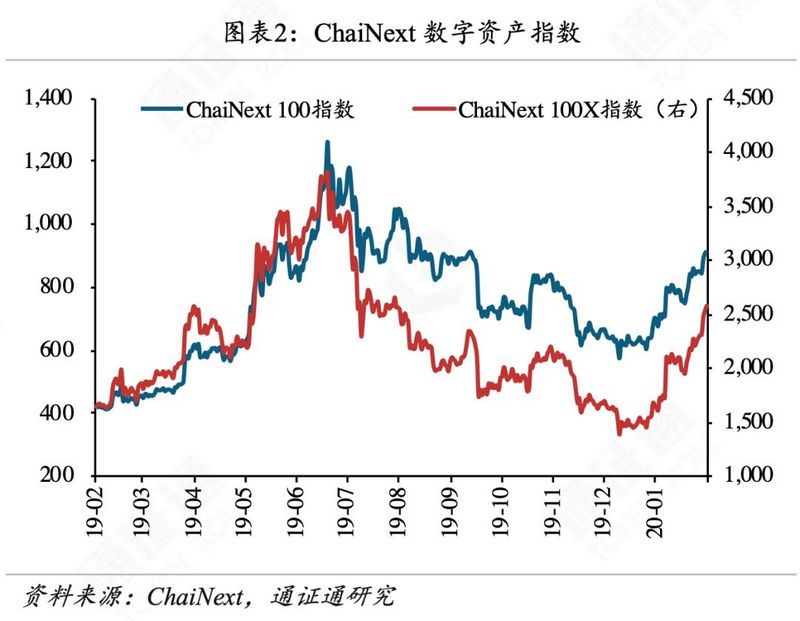
The total market value of digital tokens this week was US $ 284.42 billion, an increase of US $ 22.25 billion from last week, or an increase of about 8.5%.
The daily average volume of digital tokens this week was US $ 119.46 billion, up 12.5% from last week, and the average daily turnover rate was 44.0%, an increase of 2.5% from last week. BTC has continued to rise from the bottom of $ 6,400 for a month, and has now entered the former high key resistance zone of $ 9,500 to $ 10,500, which may form a volatile market in this range.
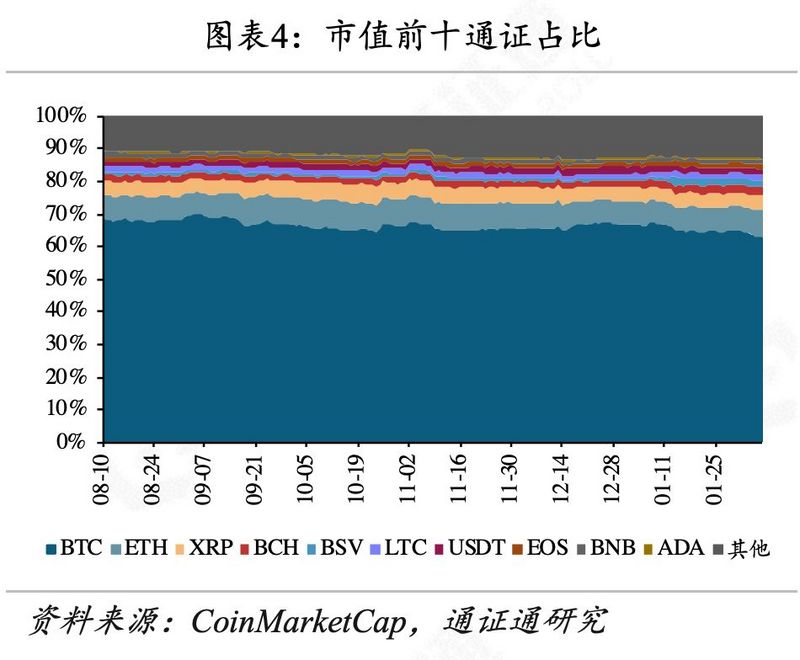
The BTC balance of the exchange this week was 798,100, which was an increase of 58,800 from last week. The exchange's ETH balance was about 10.125 million, an increase of 104,000 compared to last week. The balance of the exchange remains stable, and there is a small accumulation of chips in the market, which may cause some pressure on short-term prices.

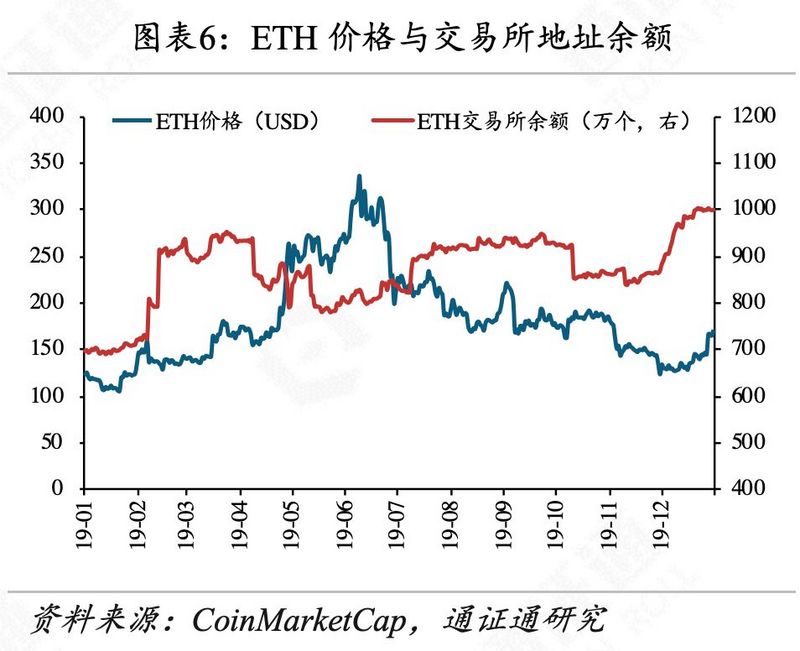
The market value of USDT is USD 4.632 billion, a decrease of USD 13.448 million from last week, which is mainly caused by the continued decline of USDT relative to the USD premium. The USDT RMB OTC transaction price rose to 7.07 yuan, with a premium of about 1%, and the domestic capital's willingness to enter the market is strong.
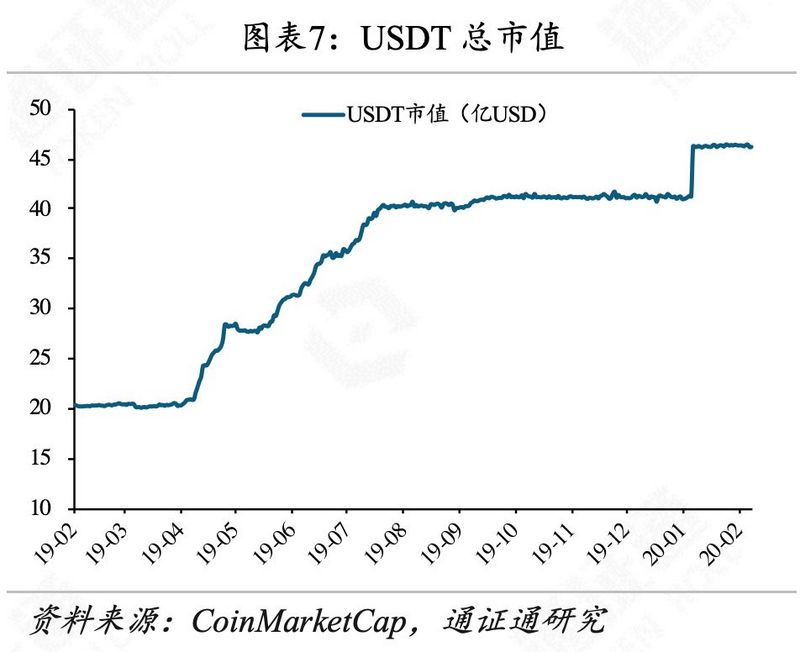
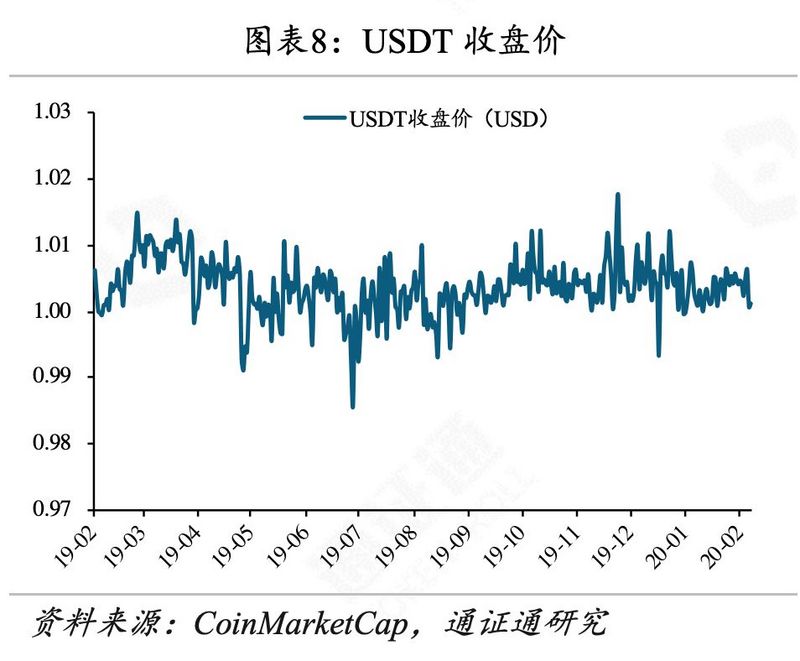
2.2 Core Token: Outbreak of Master Circulation Certificate
BTC's current price is $ 9795.9, with a weekly increase of 4.8% and a monthly increase of 21.2%. The average daily turnover is US $ 31.2 billion and the average daily turnover rate is 18.6%. BTC growth slowed compared to last week, and funds poured into the main circulation certificate.
The current price of ETH is $ 222.73, with a weekly increase of 23.6% and a monthly increase of 57.7%. The average daily turnover is 13.96 billion US dollars, and the average daily turnover rate is 63.8%. The benefits of the ETH upgrade were finally released after the market was depressed for many days, and the capital attention was relatively high.

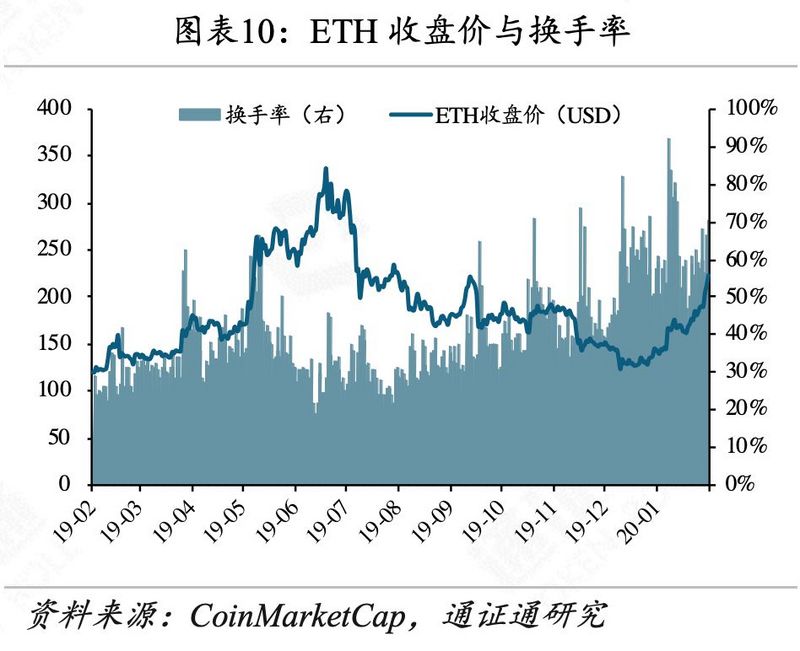
The current price of EOS is $ 4.60, with a weekly increase of 11.1% and a monthly increase of 64.9%. The average daily turnover is 3.27 billion US dollars, and the average daily turnover rate is 78.6%. The EOS market is highly active and the price fluctuations are large.
BCH's current price is 439.75 US dollars, with a weekly increase of 17.1% and a monthly increase of 82.4%. The average daily turnover is 3.95 billion US dollars, and the average daily turnover rate is 52.6%. BCH and BSV, as representatives of the concept of production reduction tokens, led the rise of the main circulation market.
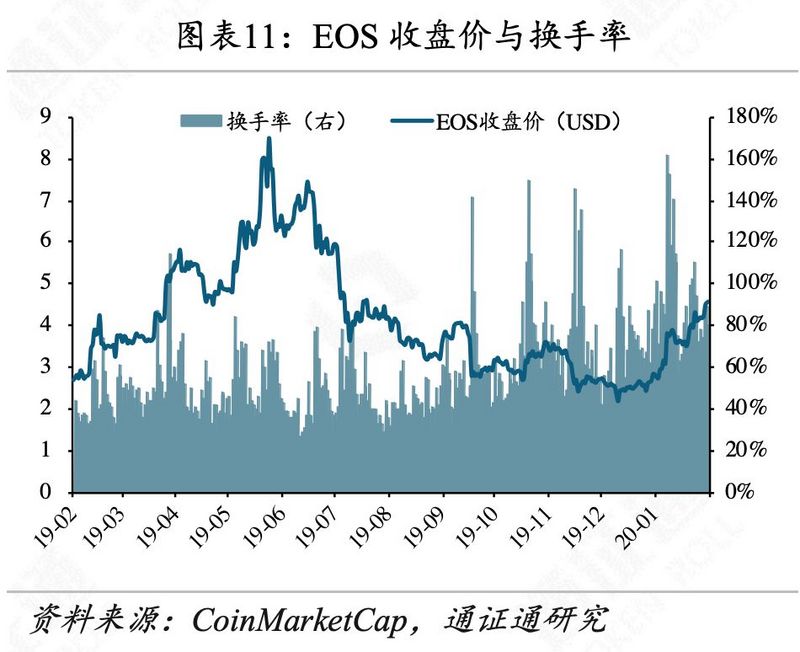
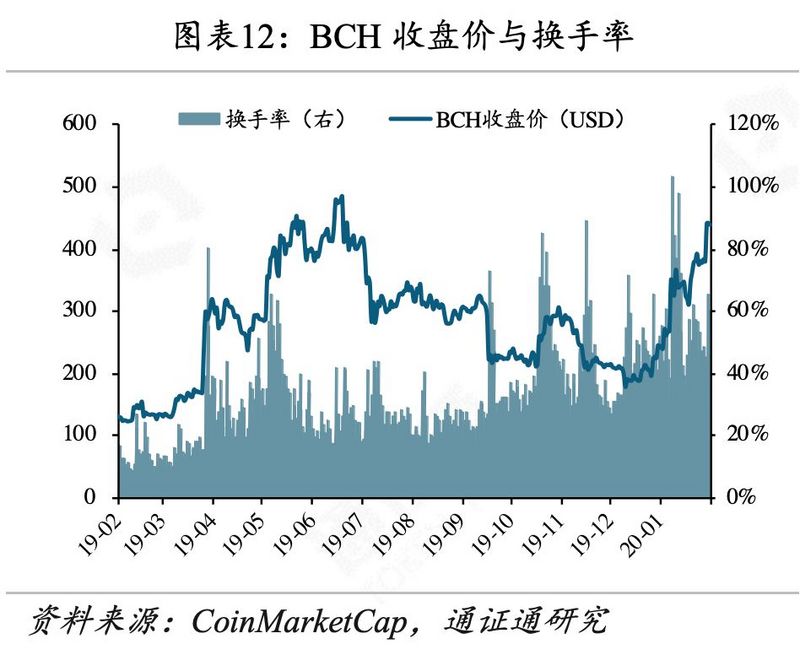
The monthly volatility of the main tokens this week has declined, and the market is still relatively active.
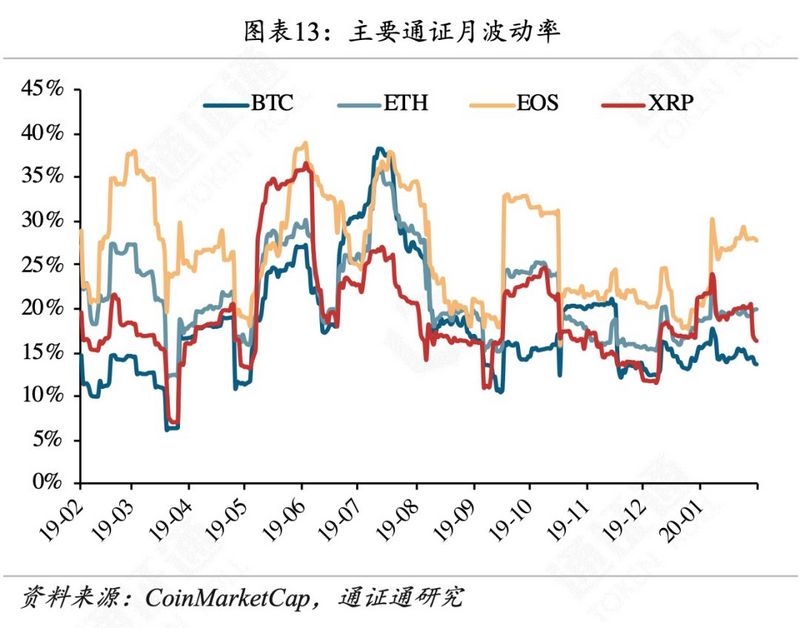
2.3 BICS Industry: Market share of operating platforms continues to grow
Among the top 500 BICS (Blockchain Industry Classification Standard) secondary industries in terms of market capitalization, the market value of operating platforms and project services increased at a higher rate, and the market value of non-bank finance and supply chains decreased. obvious.
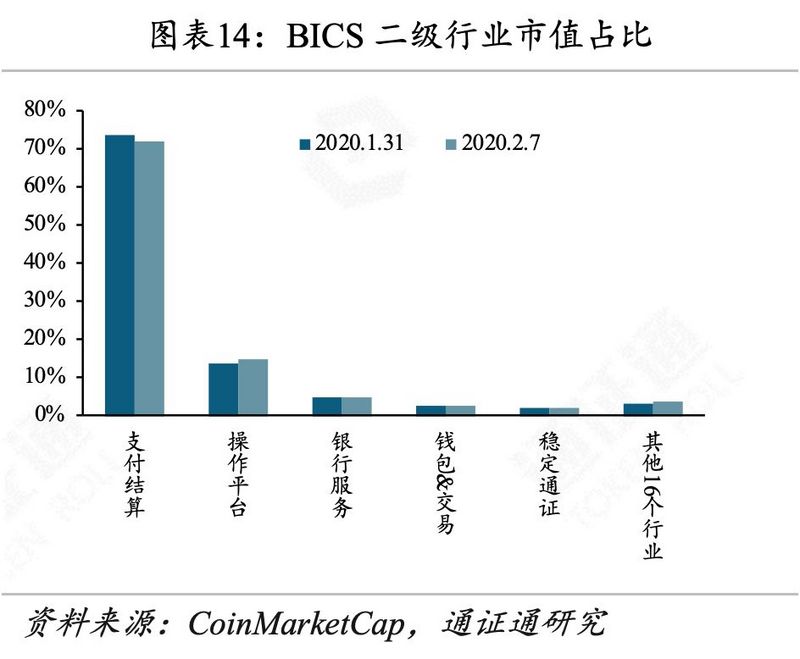
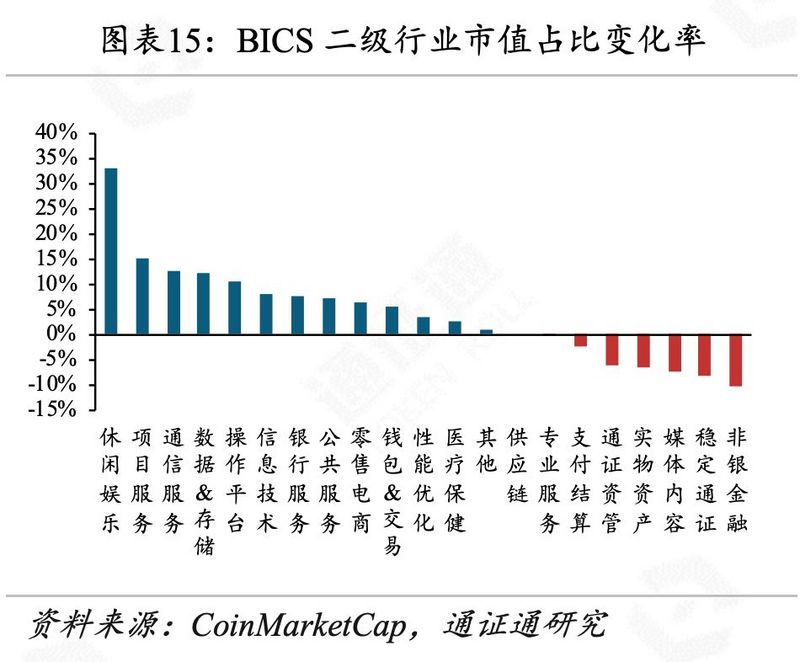
The BICS secondary industries that saw a significant increase in the number of TOP500 tokens this week are information technology (increasing 2) and banking services (increasing 2).
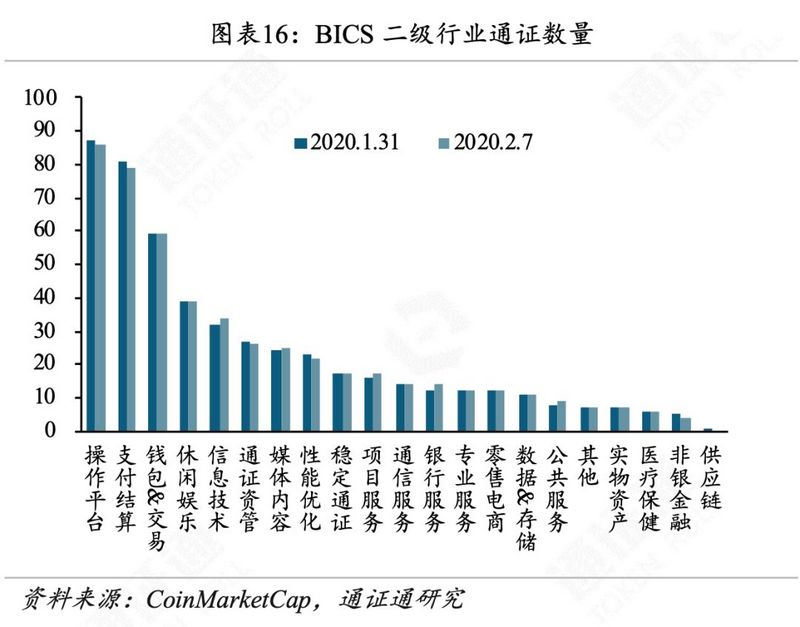
2.4 Market View: There are more opportunities for the main circulation certificate, focusing on the concept of production reduction
Since 2020, regional hotspots and black swan events have emerged endlessly. Iranian officers were "strangled" by the U.S. forces, the United Kingdom and the European Union signed a Brexit agreement, and China ’s new coronavirus pneumonia has further increased the uncertainty of the global economic outlook, and financial markets are inevitably subject to sharp fluctuations. In this context, blockchain technology, with its distributed, high-efficiency, low-cost, and non-tamperable characteristics, will emerge in the fields of international trade, bond issuance, and corporate finance, and gain the status of "digital gold."
Attention should be paid to the opportunities emerging in the main circulation certificate in the near future. At the beginning of April 2020, BCH and BSV are about to halve before BTC. Their halving market may start before BTC. There is still one month left. During this period, BCH and BSV may increase their overdraft by half in advance, ushering in the final violent pull-up market and driving the main circulation certificate to strengthen.
In the long run, there is a large imagination for high-quality tokens. The halving market will start in 2020, and callbacks are rare opportunities to increase positions. Investors can make asset allocation based on their own circumstances.
3 Output and popularity: slowing growth of computing power or ushering in an inflection point
The growth of BTC and ETH computing power has slowed. The mining difficulty of BTC this week was 15.46T, which is not adjusted this week; the average daily computing power is 110.6EH / s, which is 1.0EH / s lower than last week. ETH mining difficulty this week was 2089.9, an increase of 32.1 over last week, and an average daily computing power of 166.2 TH / S, an increase of 1.9 TH / S over last week.
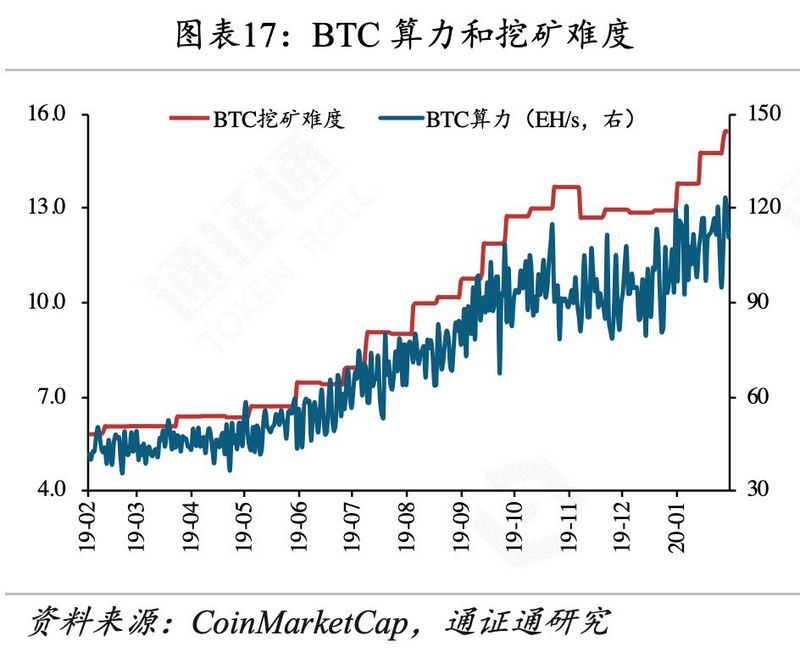
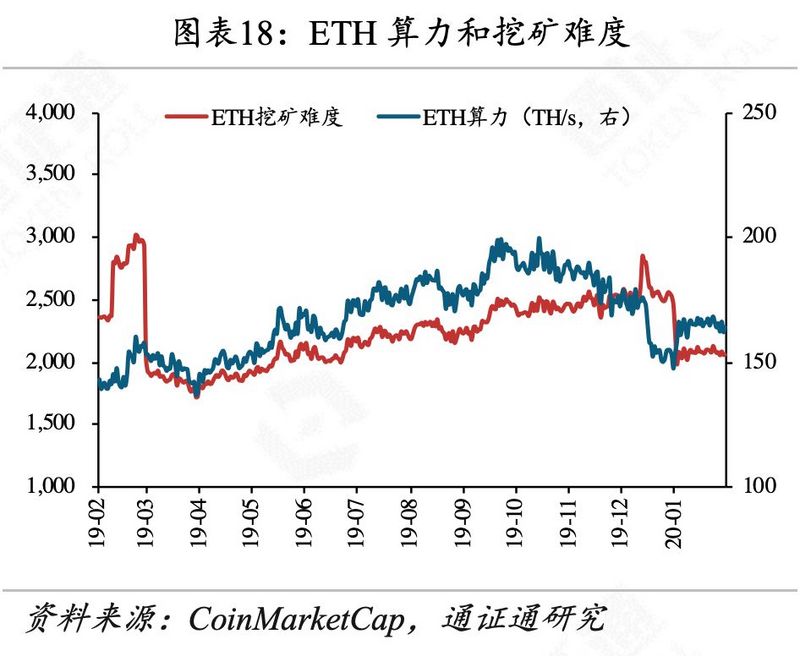
This week, Google Trends calculated that the search term for Bitcoin terms was 10 and the search term for Ethereum terms was 10, which is a significant increase compared to last week.
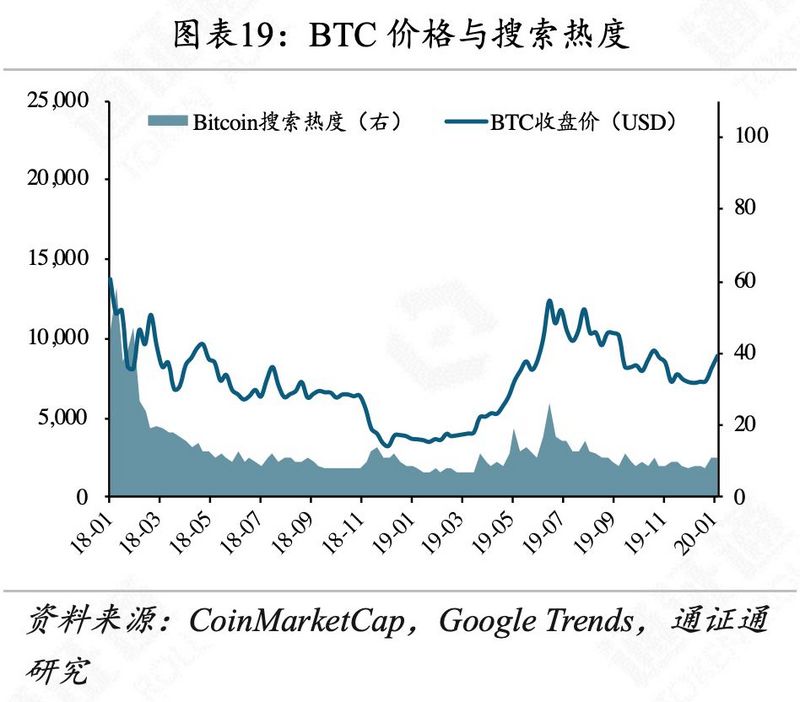

4 Industry News: Blockchain Helps Fight New Crown Pneumonia
4.1 IRS: Digital Tokens will continue to be an important focus for 2020
The US Internal Revenue Service (IRS) issued important tips for digital token holders this year to properly submit their tax returns. This is the first time that digital tax issues have been included in the tax return. More than 150 million filers are expected to disclose their Whether any cryptocurrencies were purchased or sold during the tax year. IRS Commissioner Charles Rettig said cryptocurrencies are an important addition to the 1040 filing this year. This emerging area is a priority for IRS and hopes to help taxpayers understand their obligations related to digital tokens. They will also take steps to ensure fair implementation of tax laws by those who do not comply with rules involving digital tokens. At the same time, the agency announced that digital tokens will continue to be an important focus of the IRS in 2020.
4.2 Wuhan University team launches blockchain-based information exchange platform for protection against new crown pneumonia
Member of the CCF Blockchain Professional Committee and a team of professors and students of Professor Cui Xiaohui from the National Cyber Security College of Wuhan University fought over multiple overnight emergency development of the "National Anti-Crown Pneumonia Protective Materials Information Exchange Platform-Ying Ying Shanlian V1.4". It is reported that the system covers the demand information and contact information of anti-pneumonia hospitals in Hubei Province, and will soon cover the whole country. The system realizes that the information of donors and recipients is completely open and transparent, and the two parties directly interface with each other, effectively assisting donors to quickly and accurately send protective materials to the hospital.
4.3 CCTV: The Haidian District Market Supervision Bureau does a good job of epidemic prevention and control through various methods such as blockchain
According to CCTV-4 Chinese CCTV-4 report this afternoon, in order to do a good job of epidemic prevention and control, various districts and departments in Beijing have optimized the application process, streamlined the application materials, and adopted a variety of methods to carry out online, palm and fingertips , Vigorously promote the mode of not meeting. Among them, the Haidian District Market Supervision Bureau has implemented a "in-visit" mode for business registration, pre-confirmation of corporate housing leasing, etc. by sorting out the business process of enterprises and using various methods such as Internet, telephone and blockchain technology.
4.4 Sun Yuchen has been invited to dinner with Buffett, saying that he will accept Buffett's suggestions and guidance
Tron founder Sun Yuchen said he had dinner with Buffett on January 23 at a private country club in Omaha, Nebraska, after delaying lunch with Buffett. Sun Yuchen brought several guests, including Litecoin founder Li Qiwei, eToro CEO Yoni Assia, and Huobi Chief Financial Officer Chris Lee and others. Sun Yuchen said that Buffett shared his wisdom in business, investment and daily life at dinner, and also talked about the topic of blockchain and digital tokens. Buffett said that digital tokens and blockchains are still in their infancy. Blockchains have their value, there are many excellent companies in the payment field, and there is huge demand. Buffett believes that blockchain technology will have a disruptive effect on the future of payments.
Notes:
For some reasons, some of the terms in this article are not very accurate, such as: tokens, digital tokens, digital currency, currency, tokens, crowdsale, etc. If you have any questions, you can call the letter and discuss together.
For the original report, please refer to the research report released by [Tong Tong Tong Research]: "Rethinking the New Crown: Blockchain Makes Infectious Disease Prevention and Control More Efficient-Blockchain Weekly Report 200209" 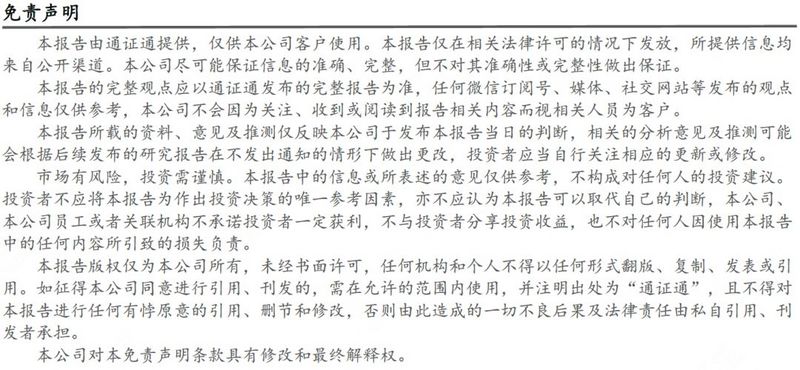
We will continue to update Blocking; if you have any questions or suggestions, please contact us!
Was this article helpful?
93 out of 132 found this helpful
Related articles
- Weekly development of industrial blockchain 丨 Anti-epidemic prevention, although the blockchain is late, it is not absent
- Babbitt weekly selection 丨 Bitcoin returns to US $ 10,000; blockchain industry explodes financing wave
- Babbitt Column | New Macroeconomics Emerging: How to Become a World Reserve Currency in the Future?
- Bitcoin price rushes 10,000, why is the peak of the on-chain data week two days ahead?
- Ethereum's Economic Bandwidth Theory: Billion Dollar Market for ETH
- Bitcoin spending accuracy levels are improving
- Forbes: 5 major trends in blockchain and distributed ledger technology in 2020






